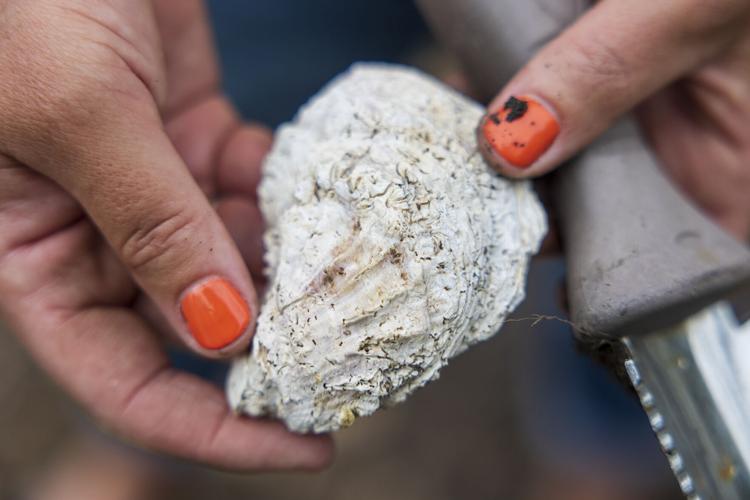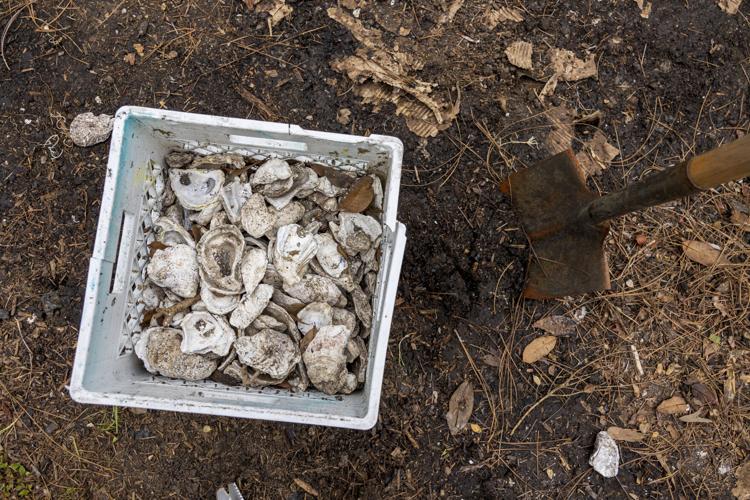When Kyran Pittman gardens in her yard in the Marlyville-Fontainebleau neighborhood of Uptown New Orleans, she can’t dig for more than a few inches before hitting “old, gnarly, large” oyster shells and clam shells, she said.
Why? Her home on Walmsley Avenue is nowhere near a body of water, and it doesn’t occupy a spot where a nearby restaurant or oyster bar might have tossed leftovers.

Kyran Pittman digs up old discarded oyster shells in the garden in the front yard of her New Orleans home on Tuesday, April 18, 2023. (Photo by Chris Granger | The Times-Picayune | The New Orleans Advocate)
Nevertheless, “every time I stick a spade in the soil, I have to go through the oyster layer,” Pittman said. “How did they get in my dirt, and why are they there at all?”
The answer, it turns out, lies in the ground beneath Pittman’s feet — or, rather, the elevated ground beneath her feet.
A former dairy farm
Pittman and her husband, Patrick Houston, live in a neighborhood bounded by South Carrollton and South Claiborne avenues, Audubon Street and the Illinois Central railroad line that was developed about a century ago. Their house sits on land that had been part of a dairy farm that was run around the turn of the 20th century by the Frederic sisters — Angelique, Marie Hortense and Josephine — who sold their products at the Dryades Market.

Some of the old oyster shells that Kyran Pittman has dug up in the garden in the front yard of her New Orleans home on Tuesday, April 18, 2023. (Photo by Chris Granger | The Times-Picayune | The New Orleans Advocate)
When the property was cleared and subdivided in the transformation from farm land to urban land, drainage — an ever-present aspect of New Orleans life — came into play.
As part of the development, sediment known in the trade as fill was brought in to shore up the residential blocks to make them a foot or two higher than the streets, thereby facilitating drainage, said Richard Campanella, the Tulane University geographer, whose latest book happens to be “Draining New Orleans: The 300-Year Quest to Dewater the Crescent City.”
“The fill could have come from anywhere,” he said.
The oyster krewe
Hence the presence of all those shells. “They’re enormous. They’re liberally mixed into that topsoil,” said Pittman, who not only loves to eat oysters but also marches with the Bearded Oysters Carnival krewe.

Kyran Pittman digs up old discarded oyster shells in the garden in the front yard of her New Orleans home on Tuesday, April 18, 2023. (Photo by Chris Granger | The Times-Picayune | The New Orleans Advocate)
Although Pittman crafts throws from some of the oysters she finds in her yard, the undisturbed shells can be good for her vegetation, said Dan Gill, a retired associate professor of horticulture at LSU AgCenter and The Times-Picayune’s longtime lawn and garden columnist.
Shells are made of calcium carbonate. Over time, calcium from those shells — an essential element for healthy plants — can go into the soil, Gill said, and the shells can help aerate the soil and keep it from compacting.
“Sometimes soils are too acidic,” he said. “Lime or calcium carbonate mixes with soil to make crops grow better.”

Kyran Pittman digs up old discarded oyster shells in the garden in the front yard of her New Orleans home on Tuesday, April 18, 2023. (Photo by Chris Granger | The Times-Picayune | The New Orleans Advocate)
Shells aren’t the only things that Pittman — a self-confessed history geek and French Quarter walking-tour guide — is finding when she digs in her yard.
Among the detritus her spade has turned up are an intact seltzer bottle more than a century old, horseshoes, big rusty nails and bits of hardware and crockery.
“Our neighborhood has been in the throes of road improvements for what seems like forever, and the workers leave plenty of trash and construction materials behind them,” Pittman said. “I hope their litter ages half as picturesquely.”
Curious Louisiana is a community-driven reporting project that connects readers to our newsrooms' resources to dig, research and find answers about the Pelican State. Bottom line: If you've got a question about something Louisiana-centric, ask us.








